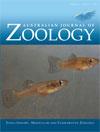The potoroids are a small group of cryptic macropodoid marsupials that are difficult to directly monitor in the wild. Consequently, information regarding their social and mating systems is limited. A population of long-nosed potoroos (Potorous tridactylus) on French Island, Victoria, was monitored from June 2005 to August 2010. Tissue samples were collected from 32 (19 ♂, 13 ♀) independent potoroos and 17 pouch young. We aimed to determine the genetic mating system and identify patterns of paternity through genotyping individuals at 10 microsatellite loci. Additionally, we investigated the importance of body mass and site residency as strategies in securing paternity. Twelve of the 17 pouch young sampled were assigned paternity with confidence to five males. Multiple pouch young were sampled from two long-term resident females, one of which had 10 pouch young sired by multiple partners, with some repeat paternity, while the other had three young sired by one male, suggesting that the mating system is not entirely promiscuous. Sires were recorded on site for significantly longer periods than non-sires but were not significantly larger than non-sires at conception. This suggests that sires employ strategies other than direct competition, such as scramble competition, to secure paternity in P. tridactylus.
How to translate text using browser tools
7 November 2012
The genetic mating system of the long-nosed potoroo (Potorous tridactylus) with notes on male strategies for securing paternity
Greta J. Frankham,
Robert L. Reed,
Mark D. B. Eldridge,
Kathrine A. Handasyde
ACCESS THE FULL ARTICLE

Australian Journal of Zoology
Vol. 60 • No. 4
January 2013
Vol. 60 • No. 4
January 2013




